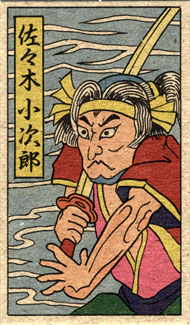SPOILERS!
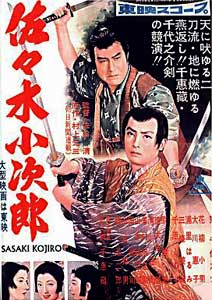 Sasaki Kojiro (1957) & immediate sequel Sasaki Kojiro Kohen (1957) are beautifully filmed widescreen black & white; scenes often look like gorgeous picture-scrolls unfolding before one's eyes. Part I opens on a misty night with torches. A search party is called out to find Otone, but she's avoiding being found. Eventually she's captured by Toma & brought before her father. Sasaki Kojiro (1957) & immediate sequel Sasaki Kojiro Kohen (1957) are beautifully filmed widescreen black & white; scenes often look like gorgeous picture-scrolls unfolding before one's eyes. Part I opens on a misty night with torches. A search party is called out to find Otone, but she's avoiding being found. Eventually she's captured by Toma & brought before her father.
Her father chastises her for trying to run off with the worthless ronin, Kojiro of no known family. Her father gives Toma permission to kill the disobedient girl. Toma is not a bad man & won't kill the woman who was supposed to have been his betrothed.
There is a roguish quality to this version of Kojiro, as played by boyishly pretty Chiyonosuke Azuma. He seduced Otone while his friend Toma was away. And yet he does love the girl & so strongly insists "I'm determined to make her my bride" that Toma with tragic visage forgives them both.
He strives to abandon his own roguish ways & seeks fame by the sword only so that the well-positioned Ichiba family will accept him as a suitable husband for Otone. He's certain they'll admire him if he is no longer a man with no family name, but a fencer of renown. "Fencing will be my way out!" he insists. His way out of loneliness; his way out of namelessness.
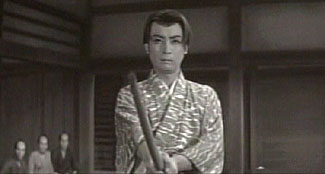 He was in fact trained by a prominent instructor, but when he shows up at Yamazaki Fencing School to make a challenge, they say they have never heard of "a man like you" having been a student. He was in fact trained by a prominent instructor, but when he shows up at Yamazaki Fencing School to make a challenge, they say they have never heard of "a man like you" having been a student.
By "man like you" they mean his effeminate nature, for he is a grown man who has not shaved his forelock (he has the hair style of a child or male prostitute) & furthermore wears garments suited more to entertainers than samurai. In the very opening scene we saw Kyoshiro dancing a women's dance in a circle otherwise exclusively of women.
This is something only Kyojiro would do, & he's perfectly aware than in his behavior & choice of appearance, he's not like other men. When his nature is used as a veiled insult, he momentarily leans forward as if to protest or show anger, but then realizes he really doesn't care if they think that way about him, just so long as he gets to prove his prowess with sword.
He fights Sakon Shogen's nephew Hyozaemon in the practice hall (dojo) winning with a single strike. Sakon Shogen then steps forth & asks, "You don't mind being crippled?" But it is Sakon Shogen who will end up crippled.
Lord Echizen was witness to the bout. But far from being impressed, Lord Echizen banishes the upstart swordsman. Kojiro's naive dream of instant success was foiled by the pride of established men.
In Horoskhi Inagaki's one-film version of the tale, Lord Echizen does not make his unjust rulilng to protect the school's reputation or pride, but honestly feels Kojiro's sense of victory is misplaced when he lacks a deeper spiritualism of swordsmanship. But even in Inagaki's version, men of the school pursue Kojiro out of misguided pride.
Toma rushes to worn Kojiro that men from the dojo are coming to avenge Hyozaemon & Sakon Shogen, as no vagrant swordsman can be permitted to live after the affront of victory against an important school.
Otone too has hurried to meet Kojiro, to go with him into exile. Still the naif, Kojiro promises her, "My abilities will make you happy!" though it's obvious that the reverse will be true, no matter how invincible he may become. And it really isn't possible for her to wander at his side.
He wanders alone from Echizen to Kyoto, stopping at fencing halls to make challenges. He's sometimes rebuffed as a nobody, elsetimes his challenges are accepted. Though he always wins, he continues to be deprived of recognition. As we view this from Kojiro's point of view, it seems really to be due to prejudice against his lack of family that keeps him at the fringe of the culture of swordsmanship, but in fact he does need to grow spiritually before mere technique has value.
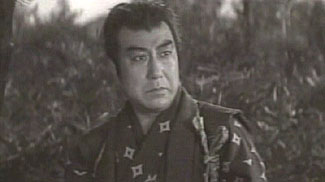 In that regard, & by contrast, the fame of Musashi Miyamoto is spreading throughout Japan, even though he likewise wanders from place to place & has a dubious heritage. Because Musashi so easily acquires the reputation that evades Kojiro, the seed of an obsession begins. He must duel Musashi to achieve his aims! In that regard, & by contrast, the fame of Musashi Miyamoto is spreading throughout Japan, even though he likewise wanders from place to place & has a dubious heritage. Because Musashi so easily acquires the reputation that evades Kojiro, the seed of an obsession begins. He must duel Musashi to achieve his aims!
He first meets Musashi on the road & offers to assist because an ambush awaits. Musashi refuses. "I fight alone. It's my way." So Kojiro watches from a hilltop as Musashi reeves through two score assailants. Kojiro thereby realizes how much he must train if he's to survive the desired match.
Musashi is not much in the film because it's not about him, but this first glimpse is very imrpessively played by Chiezo Kataoka, who owned the role for a couple of decades' worth of films.
Chiezo was not in real life much for the study of swordplay, but it never kept him from creating effective characters by sheer dramatic flourish & postures borrowed & toned down from the kabuki stage. He conveys Musashi's raw energy, & by his rough appearance provides the essential contrast to dandified Kojiro.
In Osaka, Kojiro meets a wandering singer of great beauty & skill. We soon realize his weakness for beautiful women means an easy faithlessness to Otone. He makes a bit of a fool of himself pursuing this woman, but she is a princess of the Ryukyu Islands, & her retinue keeps Kojiro at bay.
Becaise je dresses like a wakashu (youths who were frequently homosexual prostitutes), he makes a first impression of being a fancy young man with unshaven forelock. In consequence of his appearance, the Ryukyu singer's retinue mistakes him for a boy prostitute. He seems not to mind what others think; he will affect his own style no matter what, & the Ryukyu woman evidently admires this audaciousness, though keeping him at a distance.
His first bit of luck in pursuit of fame & position is to be taken under the wing of Tanba Fukushima, chief retainer to Lord Saemon Fukushima. Tanba is a good man, & Lord Fukushima is a man of considerable consequence serving the shogunate. Kojiro feels the tide is changing in his favor.
That first night in the mansion he chases away a thief, a man who by day is a street entertainer, a puppeteer. Lord Fukushima fears Kojiro may have seen secret letters recovered from the thief, & this baseless worry causes him to have Kojiro ambushed. The lord also hires Ooba the assassin to join Yamazaki men who still pursue Kojiro over the matter of defeating their school. The two-faced Lord nevertheless hires Kojiro as a vassal, to keep him close until he can be killed.
 Yamazaki men have arrived in pursuit of vengeance. They have brought Otone from Edo to lure Kojiro away from the Fukushima clan. As this plot-thread unfolds, Kojiro is witness to a wonderful dance performance for Lord Fukushima by Okuni of Izumi & her wandering troupe. She afterward helps Kojiro keep a tryst with Otone, impressed as she is that he would risk his life for love. Yamazaki men have arrived in pursuit of vengeance. They have brought Otone from Edo to lure Kojiro away from the Fukushima clan. As this plot-thread unfolds, Kojiro is witness to a wonderful dance performance for Lord Fukushima by Okuni of Izumi & her wandering troupe. She afterward helps Kojiro keep a tryst with Otone, impressed as she is that he would risk his life for love.
He must fight his way along the street to keep his tryst with Otone, where he has his "moment of joy" before all hell breaks loose. Ooba Jinnai the assassin promises to send Kojiro to hell. But our hero survives the night because helped by the puppeteer-thief, at the same time learning from the puppeteer that it it was Lord Fukushima himself who hired the assassin. Thus Kojiro flees Osaka, his seeming good fortune having been illusion.
Musashi visits the treacherous lord, thinking Kojiro is in his employ as a vassal. As for himself, he refuses the lord's offer of vassalge, & won't even stay a little while since Kojiro is gone.
A year later in Ise, Kojiro again meets Okuni of Izumi. She finds him in despair over Otone, who is being held captive by some daimyo. Okuni encourages him to further boldness for the sake of love.
We're treated to another fabulous Okuni dance, she having been the original innovator of kabuki theater, which only later excluded women. Oman, Okuni's heir apparent, falls for Kojiro. Her dancing changes due to her love.
Shimabei the puppeteer is also nearby. He is in reality a ninja spy, not just a thief or street-entertainer. He brings Kojiro the troubling news that Oobah the assassin is still on his trail. For the time being, however, Kojiro is happy in the protection of Okuni, as he attaches himself to her little troupe of onna-kabuki performers.
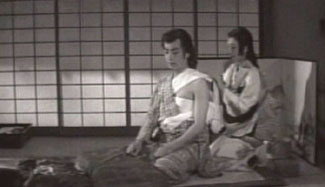 Kojiro's happiness to join the women's theater is something wakashu actually did do historically. Just as Okuni's women did a little prostitution on the side, so did the lads. Kojiro's happiness to join the women's theater is something wakashu actually did do historically. Just as Okuni's women did a little prostitution on the side, so did the lads.
This sexual ambiguity underscores Kojiro's dandified nature, & on some level it must please him to be mistaken for a boy prostitute. Yet he's not gay, unless his obsession with love of Otane, or whoever he's with at the moment, hides something deeper. But that is not an issue the film much plumbs, even though raising the issue.
Only when he realizes his presence poses a threat to the women does he continue on his own path, escaping to the mountains before falling into a trap. He was eager to have Oman flee with him, as he seems to find no contradiction in claiming to love Otone & falling in love with another woman too. As they set out together, Kojiro is wounded, & it's time for the second film of the pair.
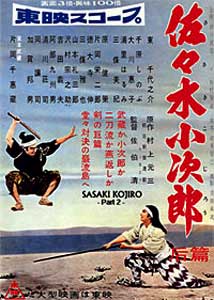 "Thanks for running away with me," says wounded Kojiro. "I appreciate it." Kojiro's quest seems up to this point less about swordsmanship than finding happiness with women. The sword is his means, not his purpose, despite that in reality it has brought him only further despair.
"Thanks for running away with me," says wounded Kojiro. "I appreciate it." Kojiro's quest seems up to this point less about swordsmanship than finding happiness with women. The sword is his means, not his purpose, despite that in reality it has brought him only further despair.
Nachimaru the pirate takes Kojori into his protection while he recouperates from injury, nursed the while by Oman who left Okuni's onna-kabuki troupe to be with the man she loves. The pirate demands one-hundred coins for his protetion. Or, barring cash, he demands an honor-debt to be collected when Kojiro is well.
Oman like Otone before her is led to believe in the highest expectations of Kojiro's faithful love. "Stay by me always!" he begs of the kabuki woman, though he already has plans to rendezvous with Otone.
This & many other film versions derive from a common source, a novel by Genzo Murakami, first serialized in Asahi Simbun, with Inagaki's first film adaptation in 1950. For its key points it plays off the life of Musashi Miyamoto as expressed in Eiji Yoshikwa's novel. Each director or screenplay adapter of Murakami's novel brings a slightly different coloration to the story, with his relationships with women, versus his relationship to the sword, especially given varied balance from film to film.
The "two women" motif echoes the story of Musashi Miyamoto who in his own story & film adaptations is pursued by Otsu & Akemi. But whereas Musashi evades women to focus on swordsmanship, Kojiro, in this version of his life & career, places love before the sword, not that the objects of his love are any better off for it.
But perhaps he's more for the sword after all, for it is the haunting face of Musashi that entices Kojiro away from the women whose devotion he so requires for happiness.
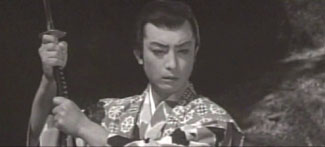 He learns from Oman's kabuki arts, performed for him by a river, a fan-waving dance, a perfect sequence for an actor who was kabuki dance coach before he was a film star. He adapts this pretty dance to his sword. He learns from Oman's kabuki arts, performed for him by a river, a fan-waving dance, a perfect sequence for an actor who was kabuki dance coach before he was a film star. He adapts this pretty dance to his sword.
In practicing his new form, two birds fall from the sky. "I killed two birds at the same time!" he brags, not noticing that Oman is horrified by the pride he has taken in his own cruelty. His "reverse swallow cut" according to legend was Kojiro's great discovery, parallelling Musashi's discovery of the two-sword style.
Often the legend says he discovered the cut by watching swallows flutter about Kintaibashi Bridge in Iwakuni, rather than on a riverbank as in this film. In this version of the legend his discovery is combined with another legend of how he took on three swordsmen, himself armed only with a fan.
Meanwhile in another place, Musashi duels a one-eyed giant monk. Praising Kii Kumano Fencing Hall, he says with gratitude, "I have learned a lot!" as he takes down a peevish monk with his two-sword style.
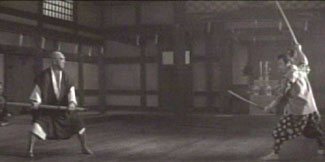 His defeat of the monks is like a little poem of battle, a delightful scene. Though he is only glimpsed in these two films, each glimpse creates an amazing impression, thanks to Chiezo Kataoka's brilliant use of his own physicality. His defeat of the monks is like a little poem of battle, a delightful scene. Though he is only glimpsed in these two films, each glimpse creates an amazing impression, thanks to Chiezo Kataoka's brilliant use of his own physicality.
Chiezo's rugged largeness as Musashi is a sharp contrast to Chiyonsuke's boyish if not girlish Kojiro, Chiyonosuke having at the time played mostly in young adult films & intentionally cast for this very contrast.
When Oman kills herself for Kojiro, he in no way repents of his cavalier methods with women, as he is always honest with his emotions & desires.
The pirate simultaneously pities Kojiro for what he has lost, while yet admiring him for his dream to fight Musashi. So he makes no claim on Kojiro's debt to him, but gives him the sword famously known as Monoshi-zao, "clothes-drying pole," as it is an unusually long nodachi rather than the katana standard for samurai. In exchange he makes one prophetic request, that the sword not be used on the giver, should they find one another on opposite sides of a battle.
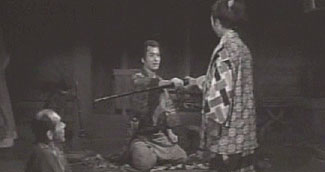 We get some background stuff about Toyotomi men hoping to re-establish their clan against the successful machinations of the Tokugawa, with intrigues involving the pirate who had befriended Kojiro. These political intrigues lend only needless plot convolutions, though hardly more than minor decorations for the telling of Kojiro's story. We get some background stuff about Toyotomi men hoping to re-establish their clan against the successful machinations of the Tokugawa, with intrigues involving the pirate who had befriended Kojiro. These political intrigues lend only needless plot convolutions, though hardly more than minor decorations for the telling of Kojiro's story.
As had been the case with Okuni, Princess Nabi of Ryukyu wants to assist in the matter of the romance of Otone & Kojiro. A lot of the Otone love interest stuff is redundant, & it sometiems seems odd that Kojiro's love is presented as greatly consequential but his faithless behavior bares no criticism.
What really dresses up the tale about this point is the character of Kosato, a kunoichi (female ninja), wife of the puppeteer spy. She's a comic relief action-girl & though not a major character, she keeps the repetitions of Kojjiro's love story from putting viewers to sleep.
The political intrigues chapter was not the most interesting, though if you happen to remember (not from this film) what Musashi was doing at the same time, there's yet another contrast between Musashi & Kojiro in play here.
These politics run their course & Kojiro is again on the road. Otone is travelling in search of him. She's played as unnecesarily faint. If she were just a tad stronger she wouldn't've just barely missed her chance to meet up with Kojiro.
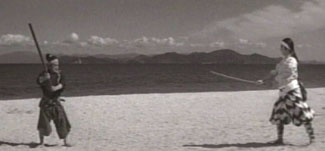 He has a stunning sequence in which he does the Okuni kabuki dance learned from Oman, while a gang of villains, led by Ooba Jinnai the assassin, try to kill him. He has a stunning sequence in which he does the Okuni kabuki dance learned from Oman, while a gang of villains, led by Ooba Jinnai the assassin, try to kill him.
This scene elegantly captures Kojiro's dual traits of violent swordsman & effeminate wakashu. The idea that Okuni's fan-dance had something about it which a swordsman might value is a very nice bit of storytelling, especially appropriate to a swordsman openly fond of girlish things.
When he founds the Ganryu fencing school, he acquires plenty of followers. He has become a famous fencer & fencing instructor, but he laments that he's never duelled Musashi, & never reunited with Otane.
She, however, does at last find her way to his dojo. It seems he has a real chance at happiness! But he cannot put aside that parallel desire to duel Musashi, believing this will mean the fulfillment of the last of his dreams.
The duel is staged in the tidal flat of Ganryu Island. Musashi seeks to unnerve his opponent by arriving late, but Kojiro is calm & peaceful.
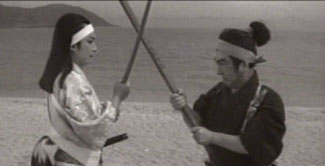 As he waits, Kojiro is able to appreciate the wildflowers above the shore. He ponders the beautifulness of the woman he loves. Musashi arrives in his own good time, by boat across the bay, having timed the tides for his easy escape, expecting Kojiro's followers to attempt vengeance. As he waits, Kojiro is able to appreciate the wildflowers above the shore. He ponders the beautifulness of the woman he loves. Musashi arrives in his own good time, by boat across the bay, having timed the tides for his easy escape, expecting Kojiro's followers to attempt vengeance.
Through all this Kojiro is focused on testing his technique & pure skill as a duelist, but Musashi is a man of tactics -- arriving late with escape route in mind & the sun behind his shoulder as a hazard to Kojiro's vision.
These events have been enacted & reenacted in so many books, stage performances, anime, comic books, games, & movies, that it's all quite familiar, but with subtle distinctions from telling to telling.
As is usual, Musashi is armed not with a sword, but a boat's oar carved into a suburito-bokken or extra-long wooden sword longer than Kojiro's nodachi. Distinct from other versions, in this take on the matter Kojiro notes Musashi's oar, & himself calls for a nodachi-length bokken or wooden sword.
Their final two blows are prettily achieved with the expected culmination. Musashi leaves as he came, never speaking a word.
copyright © by Paghat the Ratgirl
|

